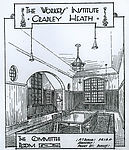 Architect's drawing of the Committee Room
Architect's drawing of the Committee Room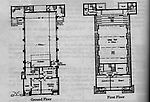 Architect's floor plans
Architect's floor plans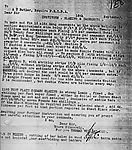 Quote from TW Camm for glazing and casements, September 1911
Quote from TW Camm for glazing and casements, September 1911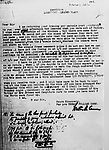 Letter to the architect from TW Camm concerning work in progress on the glazing and casements, February 1912
Letter to the architect from TW Camm concerning work in progress on the glazing and casements, February 1912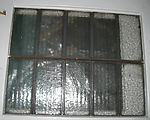 Photograph of the original glazing prior to dismantling
Photograph of the original glazing prior to dismantling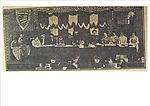 Representatives of the National Federation of Women Workers on stage at the Institute
Representatives of the National Federation of Women Workers on stage at the Institute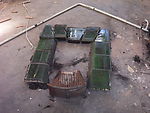 Jigsaw style fireplace
Jigsaw style fireplace Door handle
Door handle

A survey done for Sandwell council in 2001 identified many original interior fixtures and fittings. Other evidence comes from original photographs and architects drawings.
E.C. Theedam & Co. was the supplier of the original light fittings. Switches would have been bakelite. A panel of bakelite switches remained in the general office.
Many local suppliers' catalogues showed light fittings, similar to those in the architect’s sketches, and in the photograph of the stage, which shows a pendant light in the top right of the picture. The architect’s drawing shows that the committee room was lit with a central electrolier and four pendants. The bulbs in the electrolier were left unshaded in order to maximise the light available. The lamps are most likely to have been polished metal. Electrical wall sockets were not fitted originally as electrical appliances were still rare in 1912. Early appliances were fitted with bayonet style plugs, which were plugged into overhead light fittings.
The Institute was heated with a hot water system, fitted and maintained from 1912 to 1928 by Lucas & Son. Many of the rooms have also retained the original fireplaces. A green tiled "jigsaw" surround found in one of the offices is typical of the Arts and Crafts style.
The company contracted to install the glazing was TW Camm of Smethwick. Many of the interior doors had retained the original glass. The windows were leaded lights. Camm’s windows can be still be seen all over the world, including in many British churches.
Viner and Son were responsible for decorating the Institute from 1912 until 1968. We know from the opening ceremony booklet that the main hall was left as exposed brick with white grouting. Other rooms were painted, although we have no record of what colours were used. Woodwork was green. The ironwork of the roof structure was painted bronze, which would have matched other fittings.
Some of the doors are fitted with original Arts and Crafts handles. They are of a rustic design. made of a bronze coloured metal, which would match other metals in the building.
Rollover the captions in the box to see the available images in thumbnail format, click the caption to see the full-size image
| Reference: | 697 |
| Keywords: | |
| Archive Ref: | |
| Updated: | Wed 25 Jun 2008 - 1 |
| Interpretation written by | Jenny Ermoyenous |
| Author's organisation | Curatorial |
| Organisation's website |